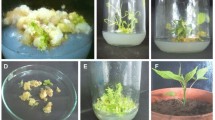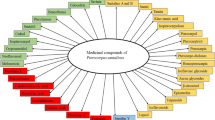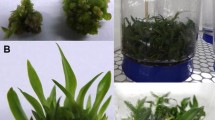Abstract
Tree peony is a well-known ornamental plant that is also valued for its medical uses and edible oil production. A long breeding period and low propagation rate are the main hurdles hindering the development of the tree peony industry, for which micropropagation can offer a solution. This article reviews the advances in tree peony micropropagation during the past three decades, providing a detailed analysis of the conditions required for the four stages of micropropagation (initiation, multiplication, in vitro rooting, and acclimatization). Additionally, potential of tree peony micropropagation for commercial application was evaluated. This review provides valuable information for the successful micropropagation of tree peony, permitting more targeted and in-depth research into tree peony micropropagation.
Key message
The review summarized in detail the results achieved in tree peony micropropagation over the last three decades. Furthermore, the potential of the existing micropropagation protocol was evaluated and the problems and the future perspectives were summarized.

Similar content being viewed by others
Change history
18 February 2020
The list of authors and affiliations in the original article was incomplete. The correct information is shown here.
Abbreviations
- 2-iP:
-
2-Isopentenyladenine
- AMF:
-
Arbuscular mycorrhizal fungi
- BA:
-
6-Benzylaminopurine
- CCFL:
-
Cold cathode fluorescent lamps
- GA3 :
-
Gibberellic acid
- IAA:
-
Indole-3-acetic acid
- IBA:
-
Indole-3-butyric acid
- iPA:
-
Isopentenyladenosine
- KT:
-
Kinetin
- LEDs:
-
Light-emitting diode
- MS:
-
Murashige and Skoog medium
- mT:
-
meta-Topolin
- NAA:
-
Naphthaleneacetic acid
- PGRs:
-
Plant growth regulators
- WPM:
-
Woody plant medium
References
Agarwal M, Shrivastava N, Padh H (2008) Advances in molecular marker techniques and their applications in plant sciences. Plant Cell Rep 27(4):617–631
Akin M, Eyduran E, Reed BM (2016) Use of RSM and CHAID data mining algorithm for predicting mineral nutrition of hazelnut. Plant Cell Tissue Organ Cult 128(2):303–316
Albers M, Kunneman B (1992) Micropropagation of Paeonia. Acta Hortic 314:85–92
An BY (2005) Studies on the establishment of in vitro regeneration system of Paeonia suffruticosa Andr. Dissertation, Northeast Forestry University
An BY, Zhao F (2005) Study on total phenolic content and PPO activity in different cultivars of tree peony. J Beihua Univ 02:169–172
Aoki N, Inoue I (1992) Studies on production of nursery stock in tree peony (Paeonia suffruticosa), 1: effects of bud position of scion, binding material, time, cultivar and temperature after grafting on graft-take of grafted tree peony. Bull Fac Agric Shimane Univ 26:83–89
Aremu AO, Bairu MW, Doleal K, Finnie JF, van Staden J (2012) Topolins: a panacea to plant tissue culture challenges? Plant Cell Tissue Organ Cult 108(1):1–16
Barton LV, Chandler C (1958) Physiological and morphological effects of gibberellic acid on epicotyl dormancy of tree peony. Contrib Boyce Thompson Inst 19:201–214
Beruto M, Curir P (2007) In vitro culture of tree peony through axillary budding. In: Jain SM, Häggman H (eds) Protocols for micropropagation of woody trees and fruits. Springer, Berlin, pp 477–497
Beruto M, Lanteri L, Portogallo C (2004) Micropropagation of tree peony (Paeonia suffruticosa). Plant Cell Tissue Organ Cult 79(2):249–255
Bouza L, Sotta B, Bonnet M, Jacques M, Arnaud Y (1992) Hormone content and meristematic activity of Paeonia suffruticosa Andr. cv. ‘Madame de Vatry’ vitroplants during in vitro rooting. Acta Hortic 320(29):213–213
Bouza L, Jacques M, Sotta B, Miginiac E (1993) The differential effect of N6-benzyl-adenine and N6-(Δ2-isopentenyl)-adenine on in vitro propagation of Paeonia suffruticosa Andr. is correlated with different hormone contents. Plant Cell Rep 12(10):593–596
Bouza L, Jacques M, Miginiac E (1994a) In vitro propagation of Paeonia suffruticosa Andr. cv. ‘Mme de Vatry’: developmental effects of exogenous hormones during the multiplication phase. Sci Hortic 57(3):241–251
Bouza L, Jacques M, Sotta B, Miginiac E (1994b) Relations between auxin and cytokinin contents and in vitro rooting of tree Peony (Paeonia suffruticosa Andr.). Plant Growth Regul 15(1):69–73
Bouza L, Jacques M, Sotta B, Miginiac E (1994c) The reactivation of tree peony (Paeonia suffruticosa Andr.) vitroplants by chilling is correlated with modifications of abscisic acid, auxin and cytokinin levels. Plant Sci 97:153–160
Bouza L, Jacques M, Miginiac E (1994d) Requirements for in vitro rooting of Paeonia suffruticosa Andr. cv. ‘Mme de Vatry’. Sci Hortic 58(3):223–233
Brito G, Lopes T, Loureiro J, Rodriguez E, Santos C (2010) Assessment of genetic stability of two micropropagated wild olive species using flow cytometry and microsatellite markers. Trees Struct Func 24:723–732
Černá K, Dedičová B, Borbélyová D (2001) Micropropagation of Paeonia arborea Donn, Syn. P. suffruticosa Andr. Acta Fytotechnica et Zootech 4:51–54
Chen XL (2005) Preliminary study on tissue culture of tree peony. Dissertation, Henan Agricultural University
Chen YP, Lian YS, Wang XL (2003) Study on development of dormant underground buds of Paeonia rockii under tissue culture condition. Acta Bot Boreali-Occidentalia Sin 23(2):314–317
Cheng FY (2007) Advances in the breeding of tree peonies and a cultivar system for the cultivar group. Int J Plant Breeding 1(2):89–104
Chu CC, Li DW (1992) Appearance and preliminary observation on the vitrification of tree peony tissue culture. J Henan Norm Univ 1:98–101
Constantine DR (1986) Micropropagation in the commercial environment. In: Withers AL, Alderson PG (eds) Plant tissue culture and its agricultural applications. Butterworths Publishers, London, pp 175–186
Ding Y, He S, Teixeira da Silva JA, Li G, Tanaka M (2010) Effects of a new light source (cold cathode fluorescent lamps) on the growth of tree peony plantlets in vitro. Sci Hortic 125(2):167–169
Fu ZZ, Du J, He SL, Wang LM, Meng YE, Wang Z (2016) Variation differences of phenolic acids during in vitro rooting of Paeonia suffruticosa plantlets. Chin Agric Sci Bull 32(25):59–64
Gao LL, Li YQ, Wang ZS, Sun GJ, Mo HZ (2018) Physicochemical characteristics and functionality of tree peony (Paeonia suffruticosa Andr.) seed protein. Food Chem 24:980–988
George EF, Sherrington PD (1984) Plant propagation by tissue culture. Springer, Berlin
George E, Hall M, Klerk G (2008) Micropropagation: uses and methods. In: George E, Hall M, Klerk G (eds) Plant propagation by tissue culture. Springer, Berlin, pp 29–64
Harris RA, Mantell S (1991) Effects of stage II subculture durations on the multiplication rate and rooting capacity of micropropagated shoots of tree paeony (Paeonia suffruticosa Andr.). J Hortic sci 66(1):95–102
Hassannejad S, Bernard F, Mirzajani F, Gholami M (2012) SA improvement of hyperhydricity reversion in Thymus daenensis shoots culture may be associated with polyamines changes. Plant Physiol Biochem 51:40–46
He SL, Chen XL, Chen L, Kong DZ, Ren NH (2005) Study on the in vitro browning prevention of tree peony using petiole as explants. Henan Sci 01:47–50
He SL, Chen L, Wang XL, Wang Z (2009) Effect of different influential factors on induction and multiplication of Paeonia suffruticosa buds in vitro. J Henan Agric Univ 43(5):511–516
He D, Wang Z, He SL (2011) Adventitious root generating process and hormone and enzyme changes in vitro Paeonia suffruticosa. Acta Hortic Sin 04:770–776
Huang YC, Chiang CH, Li CM, Yu TA (2010) Transgenic watermelon lines expressing the nucleocapsid gene of Watermelon silver mottle virus and the role of thiamine in reducing hyperhydricity in regenerated shoots. Plant Cell Tissue Organ Cult 106:21–29
Jia WQ, Xu XB, Liu HC, Li JY (2013) Study on rooting culture and rooting anatomy of tree peony ‘Wulong Pengsheng’ regenerated shoots. For Res 16(4):516–520
Kaur A, Sandhu JS (2015) High throughput in vitro micropropagation of sugarcane (Saccharum officinarum L.) from spindle leaf roll segments: cost analysis for agri-business industry. Plant Cell Tissue Organ Cult 120(1):339–350
Kevers C, Franck T, Strasser RJ, Dommes J, Gaspar T (2004) Hyperhydricity of micropropagated shoots: a typically stress-induced change of physiologicalstate. Plant Cell Tissue Organ Cult 77:181–191
Kong XS, Zhang MX (1998) The research of peony propagation technology in vitro. Northern Hortic 3:87–89
Kovalchuk IY, Mukhitdinova Z, Turdiyev T, Madiyeva G, Akin M, Eyduran E, Reed BM (2018) Nitrogen ions and nitrogen ion proportions impact the growth of apricot (Prunus armeniaca) shoot cultures. Plant Cell Tissue Organ Cult 133(2):263–273
Kunneman B, Albers M (1989) Tissue culture of peony is not yet producing plants. Bloembollencultuur 100(23):16–17
Lang YT, Lou XF (2007) The research on callus inducing and browning prevention of peony. J Henan For Sci Technol 27(1):4–6
Li P (2007) Studies on the micropropagation of tree peonies. Dissertation, Beijing Forestry University
Li P, Cheng FY (2008) Basal medium with modified calcium source and other factors influence on shoots culture of tree peony. Acta Hortic 766:383
Li HG, Kong XS (2010) The research on vitrification of Paeonia suffruticosa plantlets. J Biol 05:35–37
Li YL, Wu DY, Pan SL, Xu SL, Wei ZM, Xu ZH, Li XJ (1984) In vitro propagation of Paeonia suffruticosa. Kexue Tongbao 29:500–502
Li P, Cheng FY, Zhang YX (2008a) Effects of browning antagonists on antibrowning, growth and multiplication of tissue culture of tree peony. J Beijing For Univ 02:71–76
Li XF, Gong ZH, Sun DQ, Wang JE (2008b) The comparison of physiological indexes and the relation with browning in tissue culture about different peony species. Acta Bot Boreali-Occidentalia Sin 01:142–145
Li SS, Yuan RY, Chen LG, Wang LS, Hao XH, Wang LJ, Zheng XC, Du H (2015) Systematic qualitative and quantitative assessment of fatty acids in the seeds of 60 tree peony (Paeonia section Moutan) cultivars by GC-MS. Food Chem 173:133–140
Liu HC, Jia WQ (2010) Establishment of plantlet regeneration system of tree peony through lateral buds cutting and carving. Acta Hortic Sin 37(9):1471–1476
Lloyd G, McCown B (1980) Commercially-feasible micropropagation of mountain laurel, Kalmia latifolia, by use of shoot-tip culture. Comb Proc Int Plant Prop Soc 30:421–427
Lopes T, Capelo A, Brito G, Loureiro J, Santos C (2009) Genetic variability analyses of the somatic embryogenesis induction process in Olea spp. using nuclear microsatellites. Trees 23:29–36
Meng QX (2011) Study on the tissue culture of scaly bud of Paeonia suffruticosa Andr. Dissertation, Beijing Forestry University
Murashige T, Skoog F (1962) A revised medium for rapid growth and bio assays with tobacco tissue cultures. Physiol Plant 15(3):473–497
Qin L, Cheng FY, Zhong Y (2012) Advances in the in vitro culture and micropropagation of tree peonies during the past half century. Acta Hortic 977:39–51
Qiu JM (2010) Study on the in vitro micropropagation of tree peony. Dissertation, Beijing Forestry University
Rathore MS, Yadav P, Mastan SG, Prakash CR, Singh A, Agarwal PK (2014) Evaluation of genetic homogeneity in tissue culture regenerates of Jatropha curcas L. using flow cytometer and DNA-based molecular markers. Appl Biochem Biotech 172:298–310
Read PE, Preece JE (2009) Micropropagation of ornamentals: the wave of the future? Acta Hortic 7(7):150–159
Regalado JJ, Carmona-Martín E, Castro P, Moreno R, Gil J, Encina CL (2015) Micropropagation of wild species of the genus Asparagus L. and their interspecific hybrids with cultivated A. officinalis L., and verification of genetic stability using EST-SSRs. Plant Cell Tissue Organ Cult 121:501–510
Ren RF, Li ZD, Zhou H, Zhang LL, Jiang XR, Liu Y (2019) Changes in apoptosis-like programmed cell death and viability during the cryopreservation of pollen from Paeonia suffruticosa. Plant Cell Tissue Organ Cult. https://doi.org/10.1007/s11240-019-01732-1
Shang W, Wang Z, He SL, He D, Liu YP, Fu ZZ (2017) Research on the relationship between phenolic acids and rooting of tree peony (Paeonia suffruticosa) plantlets in vitro. Sci Hortic 224:53–60
Sreedhar RV, Venkatachalam L, Neelwarne B (2009) Hyperhydricity related morphologic and biochemical changes in Vanilla (Vanilla planifolia). J Plant Growth Regul 28:46–57
Teixeira da Silva JA, Shen MM, Yu XN (2012) Tissue culture and micropropagation of tree peony (Paeonia suffruticosa Andr.). J Crop Sci Biotech 15(3):159–168
Thimijan RW, Heins RD (1983) Photometric, radiometric, and quantum light units of measure: a review of procedures for interconversion. Hortcult Sci 18:818–822
Wang JE (2008) The research on tissue culture of peony (Paeonia suffruticosa). Dissertation, Northwest Agriculture & Forestry University
Wang H, Van Staden J (2001) Establishment of in vitro cultures of tree peonies. S Afr J Bot 67(2):358–361
Wang HY, He SL, Tanaka M, Van PT, Teixeira da Silva JA (2012) Effect of IBA concentration, carbon source, substrate, and light source on root induction ability of tree peony (Paeonia suffruticosa Andr.) plantlets in vitro. Eur J Hortic Sci 77(3):122–128
Wang Z, Wang ZL, Shen P, Wang XL, He SL (2014) Change in activities of related enzymes during rooting of peony shoots in vitro and cutting seedlings. J Northwest Agric For Univ 10:193–198
Wang X, Cheng FY, Zhong Y, Wen SS, Li LZ, Huang NZ (2016) Establishment of in vitro rapid propagation system for tree peony (Paeonia ostii). Sci Silvae Sin 05:101–110
Wang MM, Pu XP, Zhang Q (2018) Study on in vitro papid propagation technology on Paeonia ostii var. Lishizheni. Mol Plant Breeding 16(2):526–534
Wen SS (2016) Studies on the micropropagation of tree peony (Paeonia × lemoinei ‘High Noon’), Dissertation, Beijing Forestry University
Wen SS, Cheng FY, Zhong Y, Wang X, Li LZ, Zhang YX, Qiu JM (2016a) Efficient protocols for the micropropagation of tree peony (Paeonia suffruticosa ‘Jinpao Hong’, P. suffruticosa ‘Wulong Pengsheng’, and P. × lemoinei ‘High Noon’) and application of arbuscular mycorrhizal fungi to improve plantlet establishment. Sci Hortic 201:10–17
Wen SS, Cheng FY, Zhong Y (2016b) Micropropagation of tree peony (Paeonia × lemoinei ‘High Noon’) and the assessment of genetic stability by SSR analysis. Propag Ornam Plants 16(1):19–27
Wen SS, Cheng FY, Zhong Y, Wang X, Li LZ, Huang NZ (2016c) Protocol for the micropropagation of tree peony (Paeonia leimoinei ‘High Noon’). Plant Sci J 34(01):1–8
Wister JC (1995) The peonies, 2nd edn. American Peony Society, Hopkins
Yan XF (2009) Development of new tissue culture light source and its application in the tissue culture of tree peony. Dissertation, Henan Agricultural University
Yu H (1998) Tree peony. Science and Technology Publishing House, Shanghai
Yue L (2008) Effects of light independent cultivation and light-emitting diodes on the in vitro growth of Paeonia suffruticosa plantlets. Dissertation, Henan Agricultural University
Zeng D, Yuan T, Wang L (2011) The effects of AM fungus and culture substrates on colonization of arbuscular mycorrhizal for tree peony container seedling. Chin Agricul Sci Bull 27(10):108–112
Zhang YX (2008) Studies on the micropropagation of tree peonies and the effect of polyamines on in vitro rooting. Dissertation, Beijing Forestry University
Zhang JQ, Luo XF (2006) Occurrence and prevention method of brown turning in tissue culture of Paeonia suffruticosa Andr. J Shenyang Agric Univ 05:720–724
Zhang GH, Wang HM, Wang LX (2001) Study on tissue culture techniques for peony. Shandong Agric Sci 5:16–18
Zhu FY, Wang SL, Xue JQ, Li DD, Ren XX, Xue YQ, Zhang XX (2018) Morphological and Physiological changes, and the functional analysis of PdSPL9 in the juvenile-to-adult phase transition of Paeonia delavayi. Plant Cell Tissue Organ Cult 133:325–337
Acknowledgements
This work was supported by the Natural Science Foundation of Jiangsu Province (Grant No. BK20180771); the Natural Science Foundation of the Jiangsu Higher Education Institutions of China (Grant No. 18KJB220006); the Post-doctoral Science Fund of Jiangsu Province (Grant No. 1701152B); the Youth Science and Technology Innovation Fund of Nanjing Forestry University (Grant No. CX2018026); the Priority Academic Program Development of Jiangsu Higher Education Institutions (Grant No. 164120230); the College Students’ Practice and Innovation Training Project (2018NFUSPITP045).
Author information
Authors and Affiliations
Corresponding author
Additional information
Communicated by Sergio J. Ochatt.
Publisher's Note
Springer Nature remains neutral with regard to jurisdictional claims in published maps and institutional affiliations.
Rights and permissions
About this article
Cite this article
Wen, SS., Chen, L. & Tian, RN. Micropropagation of tree peony (Paeonia sect. Moutan): A review. Plant Cell Tiss Organ Cult 141, 1–14 (2020). https://doi.org/10.1007/s11240-019-01747-8
Received:
Accepted:
Published:
Issue Date:
DOI: https://doi.org/10.1007/s11240-019-01747-8




